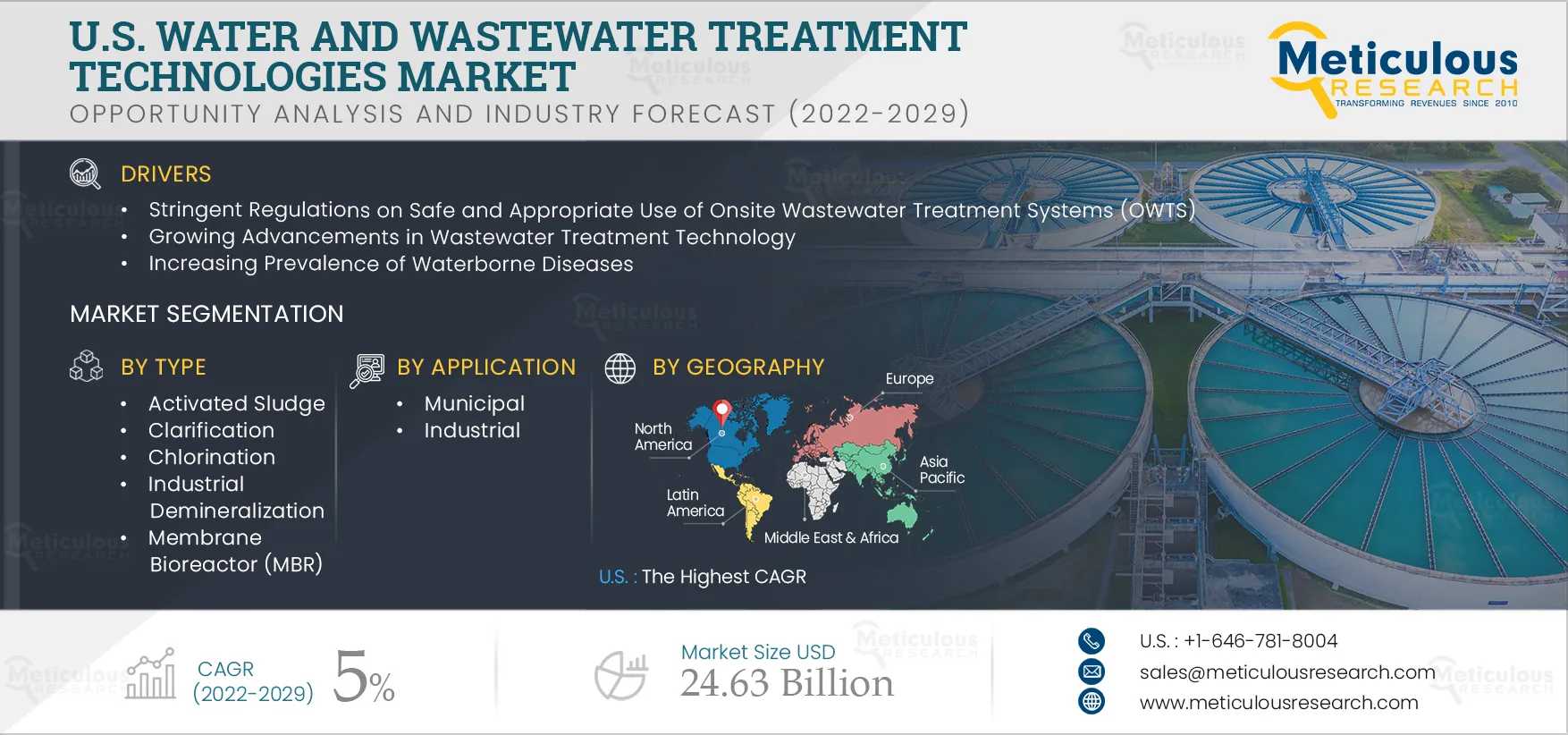The U.S. Water and Wastewater Treatment Technologies Market is expected to reach a value of $24.63 billion by 2029, at a CAGR of 5% during the forecast period 2022–2029. The growth of the U.S. water and wastewater treatment technologies market is attributed to stringent regulations on the safe and appropriate use of onsite wastewater treatment systems (OWTS), improvements in wastewater treatment technology, and the increasing prevalence of waterborne diseases.
Furthermore, the growing demand for energy-efficient and advanced water treatment technologies is expected to provide significant growth opportunities for the vendors operating in the U.S. water and wastewater treatment technologies market. However, the high installation, maintenance, and operational costs are expected to hinder the growth of this market to a notable extent. In addition, the aging and deterioration of existing water infrastructure are the challenges for the growth of the U.S. water and wastewater treatment technologies market.
Growing Advancements in Wastewater Treatment Technology
The U.S. water industry is growing rapidly, offering opportunities in different sectors, such as equipment and oil & gas. Water reuse and reclaimed water are widely applied and are increasing in these industries in the U.S.
Industrial water reuse continues to gather momentum, and onsite water reuse is becoming one of the most adaptable approaches amongst industries. There has been significant demand for technologies and approaches that foster greater water reuse and reduce pollution and conserve energy.
The U.S. faces serious challenges, such as deteriorating infrastructure and increasing contaminants. The rising demand for clean water, increased water pollution, and economic development have added to the demand for advancements in water and wastewater treatment technologies in the U.S. Some of the current advanced technologies in the U.S. are:
- Industrial Water Reuse Technologies—This technology fosters water reuse or sewer mining and can reduce pollution and energy use.
- Brine Treatment Techniques—Brine treatment is mostly driven by a shortage in available freshwater or when salt intrusion threatens groundwater.
- Stormwater Management Tools and Green Infrastructure Techniques—Stricter federal and state regulations for wastewater and stormwater systems are the main drivers for advancement in such systems.
- Nutrient Recovery and Removal Techniques—This technology reduces nutrient pollution because of stricter regulations in surface water and drinking water supplies.
- Energy Conservation and Recovery Techniques—This technology turns water and wastewater facilities into net-zero energy consumers.
The demand for clean water has increased significantly in the U.S. It has become more important to produce cleaner wastewater effluents. Thus, the growing improvements in wastewater treatment technologies can extend conventional secondary biological treatment to further stabilize oxygen demanding substances in wastewater or remove nitrogen and phosphorus.
Advanced wastewater treatment also involves physical-chemical separation techniques, such as adsorption, flocculation/precipitation, and membranes for advanced filtration, ion exchange, and reverse osmosis. The treated effluents can be reused for urban, landscape, and agricultural irrigation. Thus, the growing water concerns across the U.S. are expected to propel the adoption of advanced wastewater treatment technologies.

Click here to: Get Free Sample Pages of this Report
Key Findings of the Study:
The Membrane Separation Technology Segment to Grow Significantly During the Forecast Period
The membrane separation technology segment is expected to record the highest CAGR during the forecast period. The growth of this segment is attributed to the rising demand for low energy-consuming water treatment processes and the growing emphasis on reducing the usage of chemicals in water treatment.
The Industrial Segment Slated to Register Highest Growth
The industrial segment is expected to register the highest CAGR during the forecast period. The growth of this segment is attributed to the increasing industrialization and urbanization, declining freshwater resources, increasing energy demand across the globe, and a rising focus on water quality and public health.
Key Players
The report includes a competitive landscape based on an extensive assessment of the key strategies adopted by the leading market players in the U.S. water and wastewater treatment technologies market over the last four years.
The key players operating in the water and wastewater treatment technologies market are Suez Environnement S.A. (France), Veolia Environnement SA. (France), Xylem, Inc. (U.S.), DuPont de Nemours, Inc. (U.S.), 3M Company, Inc. (U.S.), Pentair plc (U.K.), Kurita Water Industries Ltd. (Japan), Bio-Microbics, Inc. (U.S.), Calgon Carbon Corporation (U.S.), Trojan Technologies Inc. (Canada), Ecolab, Inc. (U.S.), GFL Environmental Inc. (U.S.), and Clean TeQ Water Limited (Australia).
Scope of the Report:
U.S. Water and Wastewater Treatment Technologies Market, by Treatment Technologies Type
- Membrane Separation & Filtration
- Reverse Osmosis (RO) Membranes
- Ultrafiltration (UF) Membranes
- Microfiltration (MF) Membrane
- Nanofiltration (NF) Membranes
- Other Filtration Technologies
- Sludge Management Technology
- Activated Sludge
- Clarification
- Chlorination
- Industrial Demineralization
- Membrane Bioreactor (MBR)
- UV And Ozone
- Dissolved Air Flotation
- Electrochemical Scale Treatment Systems
- Electrochemical Water Treatment Technology (Electrocoagulation and Electro-oxidation–EEC/EEO)
- Other Treatment Technologies
U.S. Water and Wastewater Treatment Technologies Market, by Application
- Municipal
- Industrial
- Food & Beverages
- Pharmaceuticals and Chemicals
- Power Generation
- Pulp and Paper
- Oil & Gas
- Mining
- Petrochemical
- Semiconductors
- Other Industrial Applications
Key questions answered in the report:
